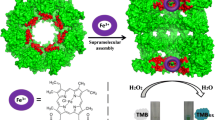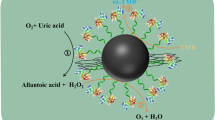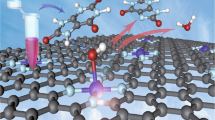Abstract
Nanozymes have received great attention owing to the advantages of easy preparation and low cost. Unlike natural enzymes that readily adapt to physiological environments, artificial nanozymes are apt to passivate in complex clinical samples (e.g., serum), which may damage the catalytic capability and consequently limit the application in biomedical analysis. To conquer this problem, in this study, we fabricated novel nanozyme@DNA hydrogel architecture by incorporating nanozymes into a pure DNA hydrogel. Gold nanoparticles (AuNPs) were adopted as a model nanozyme. Results indicate that AuNPs incorporated in the DNA hydrogel retain their catalytic capability in serum as they are protected by the hydrogel, whereas AuNPs alone totally lose the catalytic capability in serum. The detection of hydrogen peroxide and glucose in serum based on the catalysis of the AuNPs@DNA hydrogel was achieved. The detection limit of each reaches 1.7 and 38 μM, respectively, which is equal to the value obtained using natural enzymes. Besides the mechanisms, some other advantages, such as recyclability and availability, have also been explored. This nanozyme@DNA hydrogel architecture may have a great potential for the utilization of nanozymes as well as the application of nanozymes for biomedical analysis in complex physiological samples.

Similar content being viewed by others
References
Wei, H.; Wang, E. K. Nanomaterials with enzyme-like characteristics (nanozymes): Next-generation artificial enzymes. Chem. Soc. Rev. 2013, 42, 6060–6093.
Huang, Y. Y.; Liu, Z.; Liu, C. Q.; Ju, E. G.; Zhang, Y.; Ren, J. S.; Qu, X. G. Self-assembly of multi-nanozymes to mimic an intracellular antioxidant defense system. Angew. Chem., Int. Ed. 2016, 55, 6646–6650.
Wang, X. Y.; Hu, Y. H.; Wei, H. Nanozymes in bionanotechnology: From sensing to therapeutics and beyond. Inorg. Chem. Front. 2016, 3, 41–60.
Lin, Y. H.; Ren, J. S.; Qu, X. G. Nano-gold as artificial enzymes: Hidden talents. Adv. Mater. 2014, 26, 4200–4217.
Gao, L. Z.; Zhuang, J.; Nie, L.; Zhang, J. B.; Zhang, Y.; Gu, N.; Wang, T. H.; Feng, J.; Yang, D. L.; Perrett, S. et al. Intrinsic peroxidase-like activity of ferromagnetic nanoparticles. Nat. Nanotechnol. 2007, 2, 577–583.
Asati, A.; Santra, S.; Kaittanis, C.; Nath, S.; Perez, J. M. Oxidase-like activity of polymer-coated cerium oxide nanoparticles. Angew. Chem., Int. Ed. 2009, 48, 2308–2312.
André, R.; Natálio, F.; Humanes, M.; Leppin, J.; Heinze, K.; Wever, R.; Schröder, H. C.; Müller, W. E. G.; Tremel, W. V2O5 nanowires with an intrinsic peroxidase-like activity. Adv. Funct. Mater. 2011, 21, 501–509.
Yin, J. F.; Cao, H. Q.; Lu, Y. X. Self-assembly into magnetic Co3O4 complex nanostructures as peroxidase. J. Mater. Chem. 2012, 22, 527–534.
Zhang, L. L.; Han, L.; Hu, P.; Wang, L.; Dong, S. J. TiO2 nanotube arrays: Intrinsic peroxidase mimetics. Chem. Commun. 2013, 49, 10480–10482.
Liu, B. W.; Huang, Z. C.; Liu, J. W. Boosting the oxidase mimicking activity of nanoceria by fluoride capping: Rivaling protein enzymes and ultrasensitive F−detection. Nanoscale 2016, 8, 13562–13567.
Liu, B. W.; Sun, Z. Y.; Huang, P. J. J.; Liu, J. W. Hydrogen peroxide displacing DNA from nanoceria: Mechanism and detection of glucose in serum. J. Am. Chem. Soc. 2015, 137, 1290–1295.
Gao, N.; Dong, K.; Zhao, A. D.; Sun, H. J.; Wang, Y.; Ren, J. S.; Qu, X. G. Polyoxometalate-based nanozyme: Design of a multifunctional enzyme for multi-faceted treatment of Alzheimer's disease. Nano Res. 2016, 9, 1079–1090.
Shcherbakov, A. B.; Zholobak, N. M.; Baranchikov, A. E.; Ryabova, A. V.; Ivanov, V. K. Cerium fluoride nanoparticles protect cells against oxidative stress. Mater. Sci. Eng. C 2015, 50, 151–159.
Charoenkitamorn, K.; Chailapakul, O.; Siangproh, W. Development of gold nanoparticles modified screen-printed carbon electrode for the analysis of thiram, disulfiram and their derivative in food using ultra-high performance liquid chromatography. Talanta 2015, 132, 416–423.
Weerathunge, P.; Ramanathan, R.; Shukla, R.; Sharma, T. K.; Bansal, V. Aptamer-controlled reversible inhibition of gold nanozyme activity for pesticide sensing. Anal. Chem. 2014, 86, 11937–11941.
Mao, Z. G.; Qing, Z. H.; Qing, T. P.; Xu, F. Z.; Wen, L.; He, X. X.; He, D. G.; Shi, H.; Wang, K. M. Poly(thymine)- templated copper nanoparticles as a fluorescent indicator for hydrogen peroxide and oxidase-based biosensing. Anal. Chem. 2015, 87, 7454–7460.
Kim, M. I.; Cho, D.; Park, H. G. Colorimetric quantification of glucose and cholesterol in human blood using a nanocomposite entrapping magnetic nanoparticles and oxidases. J. Nanosci. Nanotechnol. 2015, 15, 7955–7961.
He, S. B.; Wu, G. W.; Deng, H. H.; Liu, A. L.; Lin, X. H.; Xia, X. H.; Chen, W. Choline and acetylcholine detection based on peroxidase-like activity and protein antifouling property of platinum nanoparticles in bovine serum albumin scaffold. Biosens. Bioelectron. 2014, 62, 331–336.
Zhu, C. D.; Zheng, Q.; Wang, L. X.; Xu, H. F.; Tong, J. L.; Zhang, Q. A.; Wan, Y.; Wu, J. Q. Synthesis of novel galactose functionalized gold nanoparticles and its radiosensitizing mechanism. J. Nanobiotechnol. 2015, 13, 67.
Villalonga, R.; Díez, P.; Eguílaz, M.; Martínez, P.; Pingarrón, J. M. Supramolecular immobilization of xanthine oxidase on electropolymerized matrix of functionalized hybrid gold nanoparticles/single-walled carbon nanotubes for the preparation of electrochemical biosensors. ACS Appl. Mater. Interfaces 2012, 4, 4312–4319.
Haider, W.; Hayat, A.; Raza, Y.; Chaudhry, A. A.; Rehman, I.; Marty, J. L. Gold nanoparticle decorated single walled carbon nanotube nanocomposite with synergistic peroxidase like activity for D-alanine detection. RSC Adv. 2015, 5, 24853–24858.
Heo, J. H.; Cho, H. H.; Lee, J. H. Surfactant-free nanoparticle-DNA complexes with ultrahigh stability against salt for environmental and biological sensing. Analyst 2014, 139, 5936–5944.
Zhu, X. L.; Shi, H.; Shen, Y. L; Zhang, B.; Zhao, J.; Li, G. X. A green method of staining DNA in polyacrylamide gel electrophoresis based on fluorescent copper nanoclusters synthesized in situ. Nano Res. 2015, 8, 2714–2720.
Violi, I. L.; Zelcer, A.; Bruno, M. M.; Luca, V.; Soer-Illia, G. J. A. A. Gold nanoparticles supported in zirconia-ceria mesoporous thin films: A highly active reusable heterogeneous nanocatalyst. ACS Appl. Mater. Interfaces 2015, 7, 1114–1121.
Zhu, X. L.; Liu, M.; Zhang, H. H.; Wang, H. Y.; Li, G. X. A chemical approach to accurately characterize the coverage rate of gold nanoparticles. J. Nanopart. Res. 2013, 15, 1900.
Zhang, S. T.; Li, H.; Wang, Z. Y.; Liu, J.; Zhang, H. L.; Wang, B. D.; Yang, Z. Y. A strongly coupled Au/Fe3O4/GO hybrid material with enhanced nanozyme activity for highly sensitive colorimetric detection, and rapid and efficient removal of Hg2+ in aqueous solutions. Nanoscale 2015, 7, 8495–8502.
Sato, K.; Hosokawa, K.; Maeda, M. Rapid aggregation of gold nanoparticles induced by non-cross-linking DNA hybridization. J. Am. Chem. Soc. 2003, 125, 8102–8103.
Myers, V. S.; Weir, M. G.; Carino, E. V.; Yancey, D. F.; Pande, S.; Crooks, R. M. Dendrimer-encapsulated nanoparticles: New synthetic and characterization methods and catalytic applications. Chem. Sci. 2011, 2, 1632–1646.
Kainz, Q. M.; Reiser, O. Polymer- and dendrimer-coated magnetic nanoparticles as versatile supports for catalysts, scavengers, and reagents. Acc. Chem. Res. 2014, 47, 667–677.
Hong, R. Y.; Li, J. H.; Chen, L. L.; Liu, D. Q.; Li, H. Z.; Zheng, Y.; Ding, J. Synthesis, surface modification and photocatalytic property of ZnO nanoparticles. Powder Technol. 2009, 189, 426–432.
Li, J.; Fan, C. H.; Pei, H.; Shi, J. Y.; Huang, Q. Smart drug delivery nanocarriers with self-assembled DNA nanostructures. Adv. Mater. 2013, 25, 4386–4396.
Caliari, S. R.; Burdick, J. A. A practical guide to hydrogels for cell culture. Nat. Methods 2016, 13, 405–414.
Hoffman, A. S. Hydrogels for biomedical applications. Adv. Drug Delivery Rev. 2012, 64, 18–23.
Annabi, N.; Tamayol, A.; Uquillas, J. A.; Akbari, M.; Bertassoni, L. E.; Cha, C. Y.; Camci-Unal, G.; Dokmeci, M. R.; Peppas, N. A.; Khademhosseini, A. 25th anniversary article: Rational design and applications of hydrogels in regenerative medicine. Adv. Mater. 2014, 26, 85–124.
Comotti, M.; Della Pina, C.; Matarrese, R.; Rossi, M. The catalytic activity of “naked” gold particles. Angew. Chem., Int. Ed. 2004, 43, 5812–5815.
Luo, W. J.; Zhu, C. F.; Su, S.; Li, D.; He, Y.; Huang, Q.; Fan, C. H. Self-catalyzed, self-limiting growth of glucose oxidase-mimicking gold nanoparticles. ACS Nano 2010, 4, 7451–7458.
Um, S. H.; Lee, J. B.; Park, N.; Kwon, S. Y.; Umbach, C. C.; Luo, D. Enzyme-catalysed assembly of DNA hydrogel. Nat. Mater. 2006, 5, 797–801.
Lee, J. B.; Peng, S. M.; Yang, D. Y.; Roh, Y. H.; Funabashi, H.; Park, N.; Rice, E. J.; Chen, L. W.; Long, R.; Wu, M. M. et al. A mechanical metamaterial made from a DNA hydrogel. Nat. Nanotechnol. 2012, 7, 816–820.
Lin, T. R.; Zhong, L. S.; Guo, L. Q.; Fu, F. F.; Chen, G. N. Seeing diabetes: Visual detection of glucose based on the intrinsic peroxidase-like activity of MoS2 nanosheets. Nanoscale 2014, 6, 11856–11862.
Lu, N. H.; Zhang, Y.; Gao, Z. H. Nitrite–glucose–glucose oxidase system directly induces rat heart homogenate oxidation and tyrosine nitration: Effects of some flavonoids. Toxicol. In Vitro 2009, 23, 627–633.
Wang, C. I.; Chen, W. T.; Chang, H. T. Enzyme mimics of Au/Ag nanoparticles for fluorescent detection of acetylcholine. Anal. Chem. 2012, 84, 9706–9712.
Zhu, X. L.; Zhao, J.; Wu, Y.; Shen, Z. M.; Li, G. X. Fabrication of a highly sensitive aptasensor for potassium with a nicking endonuclease-assisted signal amplification strategy. Anal. Chem. 2011, 83, 4085–4089.
He, W. W.; Liu, Y.; Yuan, J. S.; Yin, J. J.; Wu, X. C.; Hu, X. N.; Zhang, K.; Liu, J. B.; Chen, C. Y.; Ji, Y. L. et al. Au@Pt nanostructures as oxidase and peroxidase mimetics for use in immunoassays. Biomaterials 2011, 32, 1139–1147.
Bindhu, L. V.; Abraham, T. E. Preparation and kinetic studies of surfactant–horseradish peroxidase ion paired complex in organic media. Biochem. Eng. J. 2003, 15, 47–57.
Choi, M. M. F.; Yiu, T. P. Immobilization of beef liver catalase on eggshell membrane for fabrication of hydrogen peroxide biosensor. Enzyme Microb. Technol. 2004, 34, 41–47.
Kafi, A. K. M.; Wu, G. S.; Chen, A. C. A novel hydrogen peroxide biosensor based on the immobilization of horseradish peroxidase onto Au-modified titanium dioxide nanotube arrays. Biosens. Bioelectron. 2008, 24, 566–571.
Su, G.; Wei, Y. B.; Guo, M. L. Direct colorimetric detection of hydrogen peroxide using 4-nitrophenyl boronic acid or its pinacol ester. Am. J. Anal. Chem. 2011, 2, 879–884.
Kimberly, M. M.; Vesper, H. W.; Caudill, S. P.; Ethridge, S. F.; Archibold, E.; Porter, K. H.; Myersa, G. L. Variability among five over-the-counter blood glucose monitors. Clin. Chim. Acta 2006, 364, 292–297.
Zhu, W. J.; Feng, D. Q.; Chen, M.; Chen, Z. D.; Zhu, R.; Fang, H. L.; Wang, W. Bienzyme colorimetric detection of glucose with self-calibration based on tree-shaped paper strip. Sens. Actuators B 2014, 190, 414–418.
Kang, X. H.; Wang, J.; Wu, H.; Aksay, I. A.; Liu, J.; Lin, Y. H. Glucose oxidase-graphene-chitosan modified electrode for direct electrochemistry and glucose sensing. Biosens. Bioelectron. 2009, 25, 901–905.
Xu, X. W.; Yang, X. R. Facile colorimetric detection of glucose based on an organic Fenton reaction. Anal. Methods 2011, 3, 1056–1059.
Che, Y. X.; Zinchenko, A; Murata, S. Control of a catalytic activity of gold nanoparticles embedded in DNA hydrogel by swelling/shrinking the hydrogel’s matrix. J. Colloid Interface Sci. 2015, 445, 364–370.
Liu, B. W.; Liu, J. W. Accelerating peroxidase mimicking nanozymes using DNA. Nanoscale 2015, 7, 13831–13835.
Pautler, R.; Kelly, E. Y.; Huang, P. J. J.; Cao, J.; Liu, B. W.; Liu, J. W. Attaching DNA to nanoceria: Regulating oxidase activity and fluorescence quenching. ACS Appl. Mater. Interfaces 2013, 5, 6820−6825.
Liu, J. W. Adsorption of DNA onto gold nanoparticles and graphene oxide: Surface science and applications. Phys. Chem. Chem. Phys. 2012, 14, 10485–10496.
Acknowledgements
This work was supported by the National Natural Science Foundation of China (Nos. 21575088, 21235003, and 31200742), and the Natural Science Foundation of Shanghai (No. 14ZR1416500).
Author information
Authors and Affiliations
Corresponding authors
Additional information
These authors contributed equally to this work.
Electronic supplementary material
Rights and permissions
About this article
Cite this article
Zhu, X., Mao, X., Wang, Z. et al. Fabrication of nanozyme@DNA hydrogel and its application in biomedical analysis. Nano Res. 10, 959–970 (2017). https://doi.org/10.1007/s12274-016-1354-9
Received:
Revised:
Accepted:
Published:
Issue Date:
DOI: https://doi.org/10.1007/s12274-016-1354-9




